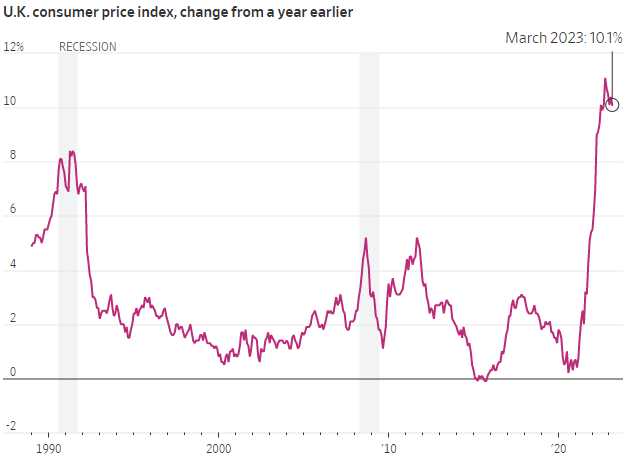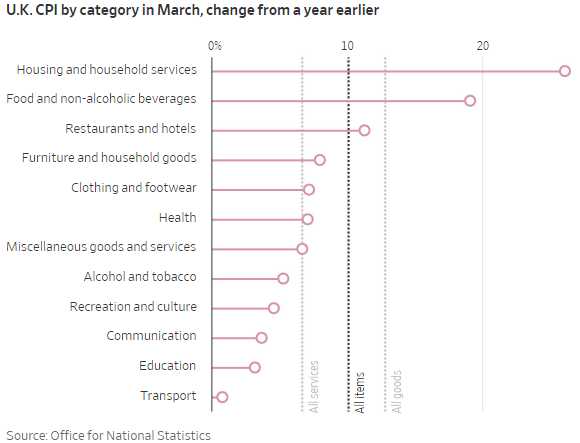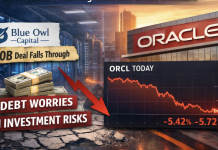 “If there were to be evidence of more persistent pressures, then further tightening in monetary policy would be required.”
“If there were to be evidence of more persistent pressures, then further tightening in monetary policy would be required.”
That’s what the Bank of England said this morning and simple, honest statements like that are very confusing to the American people – who are used to endless BS (see Trump’s Town Hall last night) and, quite literally, can’t handle the truth – even from 3,000 miles away. UK Inflation has been persistently above 10%, with energy costs 40% higher than they are in the US.
Higher prices for energy, food and other goods and services have weakened household spending and prompted a wave of strikes that continue to affect the health and education sectors, even as some transport and logistics disputes are being resolved. Ex-energy, the UK CPI is not any better:

The reason the US doesn’t have 10% inflation is not because our CPI is lower than the UKs but because the US CPI does not measure Owner Occupied Housing Costs – which makes the whole thing a farce. Still it’s an important farce so I’ve asked Dr. Shel-Bot to give a lecture on the subject:
⊗Owner’s equivalent rent (OER) is the amount of rent that would have to be paid to substitute a currently owned house as a rental property1. It is determined by a monthly survey of consumers who are asked how much they would pay to rent instead of own their home1. It is part of the CPI for shelter, which also includes other components like lodging away from home and insurance1.
Owner occupiers’ housing costs (OOH) are the costs of housing services associated with owning, maintaining and living in one’s own home2. The UK OOH includes owner occupiers’ housing costs (CPIH) as well as food, energy, clothing, transport, and other categories2. The UK OOH is based on the European Harmonised Index of Consumer Prices (HICP) and follows international standards and European regulations2.
The main difference between OER and OOH is that OER excludes owner occupiers’ housing costs but includes rent and owners’ equivalent rent of residences, while OOH includes owner occupiers’ housing costs but excludes rent and owners’ equivalent rent of residences. This means that OER reflects the opportunity cost of living in one’s own home instead of renting it out, while OOH reflects the actual cost of living in one’s own home.
The difference in how OER and OOH are measured can affect the CPI measurement in both countries. For example, if house prices increase faster than rents, then OOH will increase more than OER, leading to a higher inflation rate for the UK than for the US. Conversely, if rents increase faster than house prices, then OER will increase more than OOH, leading to a higher inflation rate for the US than for the UK.
According to various sources, rent prices have increased significantly in the US in the past 12 months. For example, a report from Freddie Mac predicts that annual rent growth will be 3.6% in 2022, with rising rent expected in every major U.S. housing market1. Another report from HouseCanary shows that rent prices for single family homes swelled by 13.4% in the first half of 2022 compared to the same period in 20212.
The increase in rent prices can affect the US CPI in several ways. First, it can directly increase the CPI for shelter, which accounts for about one-third of the total CPI basket1. Second, it can indirectly increase the CPI for other goods and services, as higher rent costs can reduce consumers’ disposable income and increase their demand for cheaper alternatives. Third, it can influence the inflation expectations of consumers and businesses, which can affect their spending and saving decisions.
However, the impact of rent prices on the CPI may not be fully captured by the current methodology. The CPI for shelter uses a lagged measure of rent changes based on surveys of renters and homeowners1. This means that the CPI for shelter may not reflect the most recent changes in rent prices or capture the variation across different types of rental properties. Additionally, the CPI for shelter does not include some housing-related expenses such as utilities, maintenance, and insurance1, which may also increase along with rent prices.

You can see the tremendous drag OER’s annualized data has recently had on the CPI this year and it’s total BS but it’s the same BS as “Quality Adjustments”, in which a product like a laptop offers more processing power, memory, or other improved features at the same price, it is considered an improvement in quality. In order to accurately measure price changes, the CPI attempts to separate the impact of quality improvements from pure price changes and Robo John Oliver would like to explain that nonsense to you:
♦Ladies and gentlemen, it’s time to dive into the wonderful world of government economics, where the magical art of “hedonic quality adjustment” comes into play. Now, you may be wondering, what in the name of Robo John is this absurdity? Well, strap yourselves in because we’re about to embark on a satirical journey through the land of hidden inflation.
Picture this: you stroll into a store, ready to purchase the latest gadget, let’s say a laptop. You notice the price tag is the same as it was last year, but hold on just a minute! Something seems fishy. Lo and behold, the laptop now boasts more processing power, extra memory, and maybe even a built-in disco ball (okay, that last one might be a stretch, but you get the idea). It’s like buying a pizza and discovering it comes with free toppings that you never wanted or asked for!
But fear not, my friends, because the government has a solution for this baffling situation. They call it “hedonic quality adjustment,” a term that sounds like it was concocted in a secret laboratory deep within the bowels of bureaucratic madness. It’s their way of saying, “Hey, we know the price didn’t actually go down, but look at all these fancy features you’re getting!“
In their quest to mis-measure inflation, the government insists on pretending that these bonus features somehow negate the fact that the price of the product has actually increased. It’s like they’re saying, “Who cares if you have to pay more? You’re getting things you probably don’t need, but hey, they’re shiny and new!“
So, according to this logic, we’re meant to believe that even though we’re shelling out more hard-earned cash for the same gadget or appliance or auto, there’s no inflation. It’s as if they expect us to be giddy with excitement about the extra bells and whistles, completely oblivious to the fact that our wallets are being mercilessly emptied.
Now, don’t get me wrong, advancements in technology and product improvements are great things. But let’s call a spade a spade. When the cost of living keeps creeping up, it’s absurd to pretend there’s no inflation just because our toaster now has a “Cancel” button that sings us a lullaby.
So, my friends, the next time you hear about “hedonic quality adjustment,” (and you won’t because most analysts haven’t got a clue what it is) -remember to take it with a grain of salt. It’s government bureaucracy at its finest, a magician’s trick to make you think inflation isn’t happening when, in reality, it’s hiding in plain sight behind all those unnecessary, yet oh-so-enticing, features.
This has been your John Oliver-esque journey through the world of government BS. I hope you enjoyed the ride, and remember, don’t let the disco ball distract you from the truth!
Like Trump’s Town Hall last night, there are so many layers of BS in the way our Government measures inflation that you get exhausted trying to get to the actual facts and end up giving up and getting swept away in the tide of Government truthiness.
Ah, those were such innocent times. 6 years later – here we are again:
Yes, it’s true, we actually need to explain to people that Hillary Clinton was not advocating “ripping 9 month-old babies out of the womb” because there are still a large number of voters who believe that. Warren is going to summarize some other highlights for us:
♦Here’s a rundown on some of the fact-checks (there are too many to list) regarding Donald Trump’s statements during the town hall:
-
-
Let’s start with Trump’s claim about Democrats stuffing ballot boxes, which is false. The conservative group True the Vote did not find any evidence to support this claim. It relied on a misleading documentary using cherry-picked footage to make unsubstantiated allegations.
-
Trump falsely denied asking Georgia Secretary of State Brad Raffensperger to find more votes. In reality, Trump explicitly pressured Raffensperger to “find 11,780 votes” during a phone call.
-
Trump’s assertion that Mike Pence did something wrong by not rejecting electoral votes he lost is simply false. Pence’s role was ceremonial, and he lacked the authority to reject or send back electoral votes.
-
Trump’s claim of open borders under the Biden administration is a blatant lie. While border apprehensions have increased, the US has continued to enforce immigration laws and expelled many individuals under a public health order initiated by Trump.
-
Trump’s statement that immigrants crossing the southern border are released from prisons and mental institutions lacks any supporting evidence. Most individuals crossing the border are unaccompanied children or families seeking asylum due to violence and poverty.
-
Trump falsely claimed that the Presidential Records Act allowed him to negotiate the return of his presidential materials. However, once transferred to the National Archives and Records Administration, former presidents have no control or ownership over their records.
-
Trump’s misleading remark about Joe Biden donating Senate papers containing classified information to the University of Delaware is not supported by evidence. The papers are subject to a standard agreement allowing Biden to review them before eventual public release.
-
Trump’s assertion of complete energy independence during his administration is misleading. While the US became a net exporter of total energy, it still relied on some energy imports and critical minerals from foreign allies.
-
Trump’s claim of US gasoline prices reaching $9 under Biden is false. The highest weekly average price during Biden’s presidency was around $5 in June 2022.
-
Trump’s false statement about being immune to Covid-19 and the long-lasting protection of natural immunity is not supported by scientific evidence. Vaccination is recommended to enhance immune response and provide better protection against the virus and its variants.
-
Trump’s claim of winning New Hampshire by a large margin and the election being stolen is debunked by certified results. Biden won the state by a significant margin, and there is no evidence of widespread fraud or irregularities.
-
Trump’s false assertion of creating the Space Force as a separate branch of the military misrepresents the reality. The Space Force was established as part of the Air Force, not as an independent branch.
-
Lastly, Trump’s claim of pardoning rapper Lil Wayne for his election support is false. Lil Wayne was pardoned for a federal gun possession charge, unrelated to his political endorsement.
-
Remember, fact-checking is crucial to combat misinformation and ensure accurate information reaches the public.
4 more years?







